Robust Wireless Local Area Networks Based on Compressed Sensing
Abstract
:1. Introduction
2. Overview of the Related Works
- Classifying the packet behavior based on the payload, that is, Payload-Based Classification (PBC). In this method, packets are classified based on the fields of the payload, such as source wireless node, or destination wireless node, or both.
- Classification based on statistical algorithms in a WLAN that use statistical analysis of the network traffic behavior, like inter-packet arrival, session time, frequency, packet delay, bandwidth, accuracy, and so on.
3. Proposed Algorithms
3.1. RTNTM Algorithm
- There is a total of N wireless nodes randomly located in a WLAN.
- We denote K as the number of random sparse wireless nodes.
- K is a random number and is much smaller than N.
- We denote [D]N×1 as the event vector.
- Each component of [D]N×1 has a random value.
- Obviously [D]N×1 is a sparse vector since K ≤ N
- There are M active monitoring wireless nodes trying to capture K events.
- The number of events K, the number of active wireless nodes M, and total of sources N, have the following relation [32]:K ≤ M << N
- We are able to organize a network traffic framework to help in ensuring the quality of service in a given wireless local area network.
- We can classify network traffic to allow us to organize traffic of packets into the traffic of packet classes or categories, on the basis of whether the traffic of packets matches specific criteria.
- We can classify network traffic as the foundation for enabling many QoS features in the WLANs.
- We can classify network traffic to a set of group traffic classes in order to apply specific QoS treatments. The QoS treatments might include faster forwarding packets from wireless nodes by intermediate wireless routers and switches, or reduced probability of the traffic being dropped due to lack of buffering resources.
- We can identify and categorize network traffic into traffic classes for different types of networks, effectively separating network traffic into different paths.
- We can classify network traffic by using class maps and policy maps with the Modular Quality of Service Command-Line Interface (MQC) method, in order to improve the level of QoS.
- Consider the pairs of measured QoS and the multiple attribute values as input for the CS.
- Estimates a multiple attribute compressed vector in which each element indicates the degree of QoS degradation caused by each wireless networking segment or device.
- Apply the estimated multiple attribute vector to identify the cause of QoS degradation.
- Apply segmentation algorithm to the WLAN in order to define the required number of segments [32]. The number of segments is calculated based on the following equation:which M is the number of segments and N is the number of wireless nodes in the WLAN.M = C log (5N) with C between 20–25
- Collect QoS vector for each segment.
- Generate compressed [QoS]M×N matrix.
- Check the performance of the compressed [QoS]M×N matrix based on the following condition:where Y is a random vector of [QoS]M×N. If [QoS]M×N matrix satisfies the condition (2), we can go the next step. Otherwise, we need to improve the quality of [QoS]M×N matrix.(1 − C)║[QoS]M×NY║2 ≤ (1 + C)║Y║
- Calculate the degradation degree of [QoS]M×N matrix.
- Calculate Packet Loss Matrix (PLS) and Mean Opinion Score (MOS). PLS is a quantitative measure of information lost over a WLAN and MOS is a good measure of QoS.
- Check the performance of the network based on MOS number. Table 1 compares the different quality levels of a WLAN to the different number of MOS.
- (1)
- Estimate the end-to-end QoS in the normal state.
- (2)
- Calculate the degree of end-to-end QoS degradation by subtracting the estimated QoS in the normal.
- (3)
- Subtract a baseline from then apply the CS to the data after subtracting it.
- (4)
- Construct an estimation of QoS.
- (5)
- Estimate the coefficients for CS with the least squares approach.
- (6)
- Estimate QoS degradation vector.
- (7)
- Identifies which attributes are causing the QoS degradation.
- (8)
- Calculate degradation indicator.
- (9)
- Calculate the correlation between latency and signal strength indicator (SSI).
- Detect, diagnose, and resolve network performance issues and errors either for each user or each networking device.
- Track response time, transmission rate, power management, availability and uptime of routers, switches and other networking devices.
- Analyze and monitor network bandwidth performance, modulation, protocol, network traffic, and traffic patterns.
- Manage and control bandwidth of each wireless user and application.
- Graphically display routing metrics, network performance metrics in real-time, based on dynamic routing protocol.
- The input data set of a WLAN partition into a random number of clusters
- Iterate over all data vectors to determine clusters based on nearest subspace
- Compute the data vector’s contribution to the total residual by re-assignment of the input data vectors to their found clusters
- The algorithm is repeated by alternate applications of Steps 2 and 3 until convergence.
- Analyze and monitor network bandwidth performance, modulation, protocol, network traffic, and traffic patterns.
- Manage and control bandwidth of each user, class, wireless node, and application.
3.2. RTNTC Algorithm
- The CM sorts all cases from the packets into classes, by determining whether the predicted value of each packet matched the actual value of each packet.
- All the packets in each class are then counted, and the totals are displayed in the CM.
- The classification matrix is applied to evaluate the performance of the classification algorithm.
- The proposed RTNTC classification algorithm uses a set of features or parameters of packets to characterize each class, where these features should be relevant to the suitable classes. The set of known objects is called the training set, because it is used by the proposed classification algorithm to learn how to classify different packets.
- The proposed RTNTC algorithm is based on two phases to construct a robust classifier. In the training phase, the training set is used to decide how the parameters ought to be weighted and combined, in order to separate the various classes of packets. In the application phase, the weights determined in the training set are applied to a set of packet objects that do not have known classes in order to determine what their classes are likely to be in any wireless path or wireless device.
- The proposed RTNTC algorithm is based on a nearest-neighbor approach. In this method, one packet simply finds in the N-dimensional feature space the closest packet from the training set to an object being classified.
4. Simulation Results
- Dataset was obtained through the following experiments in three WLANs.
- The experiment participants used various types of wireless networking devices in three WLANs, each was capable of measuring QoS and accessing internet sites from various locations.
- For each access, the latency of WLAN was measured and collected as the end-to-end QoS.
- At the same time, the attribute information of the WLAN was also collected.
- The QoS of WLANs was measured using the speed test application. The proposed architecture allows reducing DDP to 15%, BER to 14% at each wireless node, FDR to 25%, and PD to 15%, which are good records for WLANs. The proposed architecture increased DT to 22% and S/N ratio to 17%, and 10% accuracy of wireless transmission.
5. Conclusions
Conflicts of Interest
References
- Chanthong, R.; Wuttidittachotti, P.; Daengsi, T. A study of G.711 and ILBC over WLAN 802.11n with EDCA. In Proceedings of the 2015 International Conference on Information Networking (ICOIN), Siem Reap, Cambodia, 12–14 January 2015; pp. 189–193. [Google Scholar]
- Hunger, A.; Klein, P.A. Equalizing latency peaks using a redundant multipath-TCP scheme. In Proceedings of the 2016 International Conference on Information Networking (ICOIN), Kota Kinabalu, Malaysia, 13–15 January 2016; pp. 184–189. [Google Scholar]
- Li, B.; Kim, K. A real-time routing protocol for (mk)-firm streams in wireless sensor networks. In Proceedings of the 2013 IEEE Eighth International Conference on Intelligent Sensors Sensor Networks and Information Processing, Melbourne, Australia, 2–5 April 2013; pp. 129–134. [Google Scholar]
- Salah, H.B.; Benzina, A.; Khalgui, M. Verification of Reconfigurable NoC under Quality of Service Constraints. In Proceedings of the 2016 IEEE 40th Annual Computer Software and Applications Conference (COMPSAC), Atlanta, GA, USA, 10–14 June 2016; Volume 1, pp. 329–334. [Google Scholar]
- Lee, H.; Park, K.J.; Ko, Y.B.; Choi, C.H. Wireless LAN with medical-grade QoS for e-healthcare. J. Commun. Netw. 2011, 13, 149–159. [Google Scholar] [CrossRef]
- Son, S.; Park, K.-J.; Park, E.-C. Admission control in medical-grade WLAN. In Proceedings of the 2014 Sixth International Conference on Ubiquitous and Future Networks (ICUFN), Shanghai, China, 8–11 July 2014; pp. 541–542. [Google Scholar]
- Zen, H.; Habibi, D.; Ahmad, I. Self-restraint Admission Control for adhoc WLANs. In Proceedings of the ATNAC 2008 Telecommunication Networks and Applications Conference, Adelaide, Australia, 7–10 December 2008; pp. 186–191. [Google Scholar] [CrossRef]
- Liu, Y.; Pawar, S.S.; Assi, C.; Agarwal, A. Dynamic Admission and Congestion Control for Real-time Traffic in IEEE 802.11e Wireless LANs. In Proceedings of the 2006 IEEE International Conference on Wireless and Mobile Computing, Networking and Communications, Montreal, QC, Canada, 19–21 June 2006; pp. 419–426. [Google Scholar] [CrossRef]
- Mamaghanian, H.; Khaled, N.; Atienza, D.; Vandergheynst, P. Compressed Sensing for Real-Time Energy-Efficient ECG Compression on Wireless Body Sensor Nodes. IEEE Trans. Biomed. Eng. 2011, 58, 2456–2466. [Google Scholar] [CrossRef] [PubMed]
- Chen, F.; Chandrakasan, A.P.; Stojanovic, V.M. Design and Analysis of a Hardware-Efficient Compressed Sensing Architecture for Data Compression in Wireless Sensors. IEEE J. Solid-State Circuits 2012, 47, 744–756. [Google Scholar] [CrossRef]
- Chen, F.; Chandrakasan, A.P.; Stojanovic, V. A signal-agnostic compressed sensing acquisition system for wireless and implantable sensors. In Proceedings of the 2010 IEEE Custom Integrated Circuits Conference (CICC), San Jose, CA, USA, 19–22 September 2010; pp. 1–4. [Google Scholar]
- Balouchestani, M.; Raahemifar, K.; Krishnan, S. Compressed Sensing in Wireless Sensor Networks: Survey. Can. J. Multimed. Wirel. Netw. 2011, 2, 1–4. [Google Scholar]
- Balouchestani, M.; Raahemifar, K.; Krishnan, S. Power Management of Wireless Sensor Networks with Compressed Sensing Theory. In Proceedings of the 16th IEEE International Conference on Networks and Optical Communications and 6th Conference on Optical Cabling and Infrastructure (OC&I) Northumbria University, Newcastle upon Tyne, UK, 9–10 July 2011; pp. 122–125. [Google Scholar]
- Balouchestani, M.; Raahemifar, K.; Krishnan, S. Concepts for Designing Low-Power Wireless Sensor Networks with Compressed Sensing Theory. In Proceedings of the International Conference on Communication and Broadband Networking (ICCBN 2011), Kuala Lumpur, Malaysia, 3–5 November 2011; pp. 47–51. [Google Scholar]
- Ye, H.; Walsh, G.C.; Bushnell, L.G. Real-time mixed-traffic wireless networks. IEEE Trans. Ind. Electron. 2001, 48, 883–890. [Google Scholar] [CrossRef]
- Yeon, H.J.; Sahu, S.K.; Park, W.; Lee, J.W.; Lee, J. Adaptive transmission scheme using dynamic aggregation and fragmentation in WLAN MAC. In Proceedings of the 2014 IEEE Wireless Communications and Networking Conference (WCNC), Istanbul, Turkey, 6–9 April 2014; pp. 1532–1537. [Google Scholar] [CrossRef]
- Podolanko, J.; Datta, S.; Das, S.K. Performance analysis of real-time traffic over 802.11n Wireless Local Area Networks: An experimental study. In Proceedings of the 2014 International Wireless Communications and Mobile Computing Conference (IWCMC), Nicosia, Cyprus, 4–8 August 2014; pp. 453–457. [Google Scholar] [CrossRef]
- Frantti, T.; Majanen, M. Real-time traffic control for multihomed devices. In Proceedings of the International Conference on Information Networking 2013 (ICOIN), Bangkok, Thailand, 28–30 January 2013; pp. 113–118. [Google Scholar] [CrossRef]
- Kanoun, K.; Mamaghanian, H.; Khaled, N.; Atienza, D. A real-time compressed sensing-based personal electrocardiogram monitoring system. In Proceedings of the Design, Automation & Test in Europe Conference & Exhibition (DATE), Grenoble, France, 14–18 March 2011; pp. 1–6. [Google Scholar]
- Haupt, J.; Bajwa, W.U.; Rabbat, M.; Nowak, R. Compressed Sensing for Networked Data. IEEE Signal Process. Mag. 2008, 25, 92–101. [Google Scholar] [CrossRef]
- Luo, J.; Xiang, L.; Rosenberg, C. Does compressed sensing improve the throughput of wireless sensor networks? In Proceedings of the IEEE International Conference Communications (ICC), Cape Town, South Africa, 23–27 May 2010; pp. 1–6. [Google Scholar]
- Yang, X.; Tao, X.; Dutkiewicz, E.; Huang, X.; Guo, Y.J.; Cui, Q. Energy-Efficient Distributed Data Storage for Wireless Sensor Networks Based on Compressed Sensing and Network Coding. IEEE Trans. Wirel. Commun. 2013, 12, 5087–5099. [Google Scholar] [CrossRef]
- Balouchestani, M.; Raahemifar, K.; Krishnan, S. Robust Wireless Sensors with Compressed Sensing Theory. Commun. Comput. Inf. Sci. J. Springer 2012, 293, 608–619. [Google Scholar]
- Ermis, E.B.; Saligrama, V. Dynamic thresholding for distributed multiple hypotheses testing. In Proceedings of the SSP ’07. IEEE/SP 14th Workshop Statistical Signal Processing, Madison, WI, USA, 26–29 August 2007; pp. 675–679. [Google Scholar]
- Al-Karaki, J.N.; Kamal, A.E. Routing techniques in wireless sensor networks: A survey. IEEE Wirel. Commun. 2004, 11, 6–28. [Google Scholar] [CrossRef]
- D’Andrea, E.; Ducange, P.; Lazzerini, B.; Marcelloni, F. Real-Time Detection of Traffic from Twitter Stream Analysis. IEEE Trans. Intell. Transp. Syst. 2015, 16, 2269–2283. [Google Scholar] [CrossRef]
- Wei, H.; Sun, B.; Jing, M. BalancedBoost: A hybrid approach for real-time network traffic classification. In Proceedings of the 2014 23rd International Conference on Computer Communication and Networks (ICCCN), Shanghai, China, 4–7 August 2014; pp. 1–6. [Google Scholar] [CrossRef]
- Tongaonkar, A.; Keralapura, R.; Nucci, A. SANTaClass: A Self Adaptive Network Traffic Classification system. In Proceedings of the IFIP Networking Conference, Brooklyn, NY, USA, 22–24 May 2013; pp. 1–9. [Google Scholar]
- Choudhury, P.; Kumar, K.R.P.; Athithan, G.; Nandi, S. Analysis of VBR coded VoIP for traffic classification. In Proceedings of the 2013 International Conference on Advances in Computing, Communications and Informatics (ICACCI), Mysore, India, 22–25 August 2013; pp. 90–95. [Google Scholar] [CrossRef]
- Balouchestani, M.; Raahemifar, K.; Krishnan, S. New sampling approach for wireless ECG systems with compressed sensing theory. In Proceedings of the IEEE International Symposium Medical Measurements and Applications Proceedings (MeMeA), Gatineau, QC, Canada, 4–5 May 2013; pp. 213–218. [Google Scholar]
- Balouchestani, M.; Raahemifar, K.; Krishnan, S. Low power wireless body area networks with compressed sensing theory. In Proceedings of the IEEE 55th International Midwest Symposium on Circuits and Systems (MWSCAS), Boise, ID, USA, 5–8 August 2012; pp. 916–919. [Google Scholar]
- Balouchestani, M.; Raahemifar, K.; Krishnan, S. New Testing Method in Wireless Sensor Networks with Compressed Sensing Theory. In International Conference on Computer Communication and Management (ICCCM2011); IACSIT Press: Sydney, Australia, 2011; Volume 5, pp. 1–6. [Google Scholar]
- Balouchestani, M.; Krishnan, S. Advanced K-means clustering algorithm for large ECG data sets based on a collaboration of compressed sensing theory and K-SVD approach. J. Signal Image Video Process. 2016, 10, 113–120. [Google Scholar] [CrossRef]
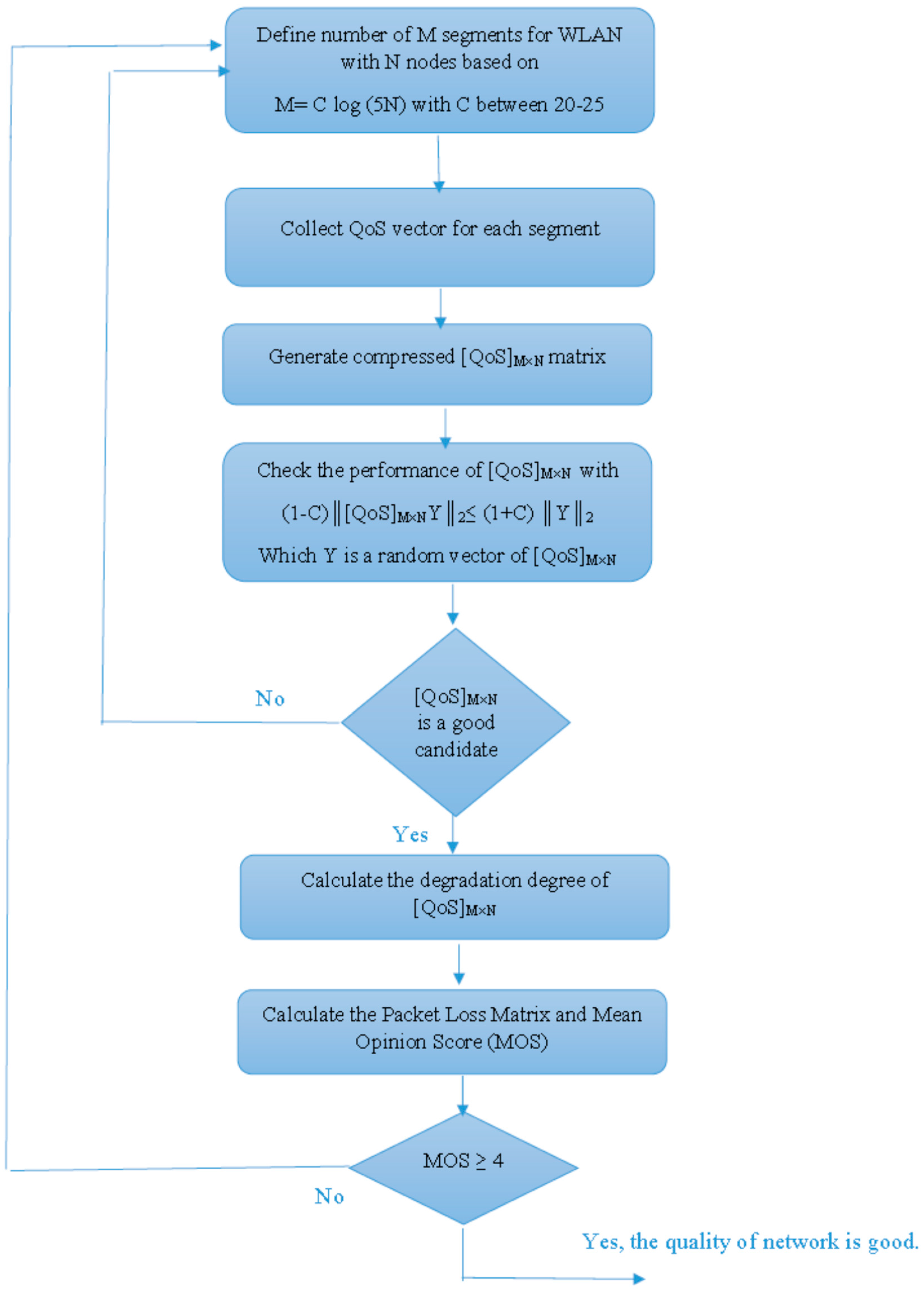
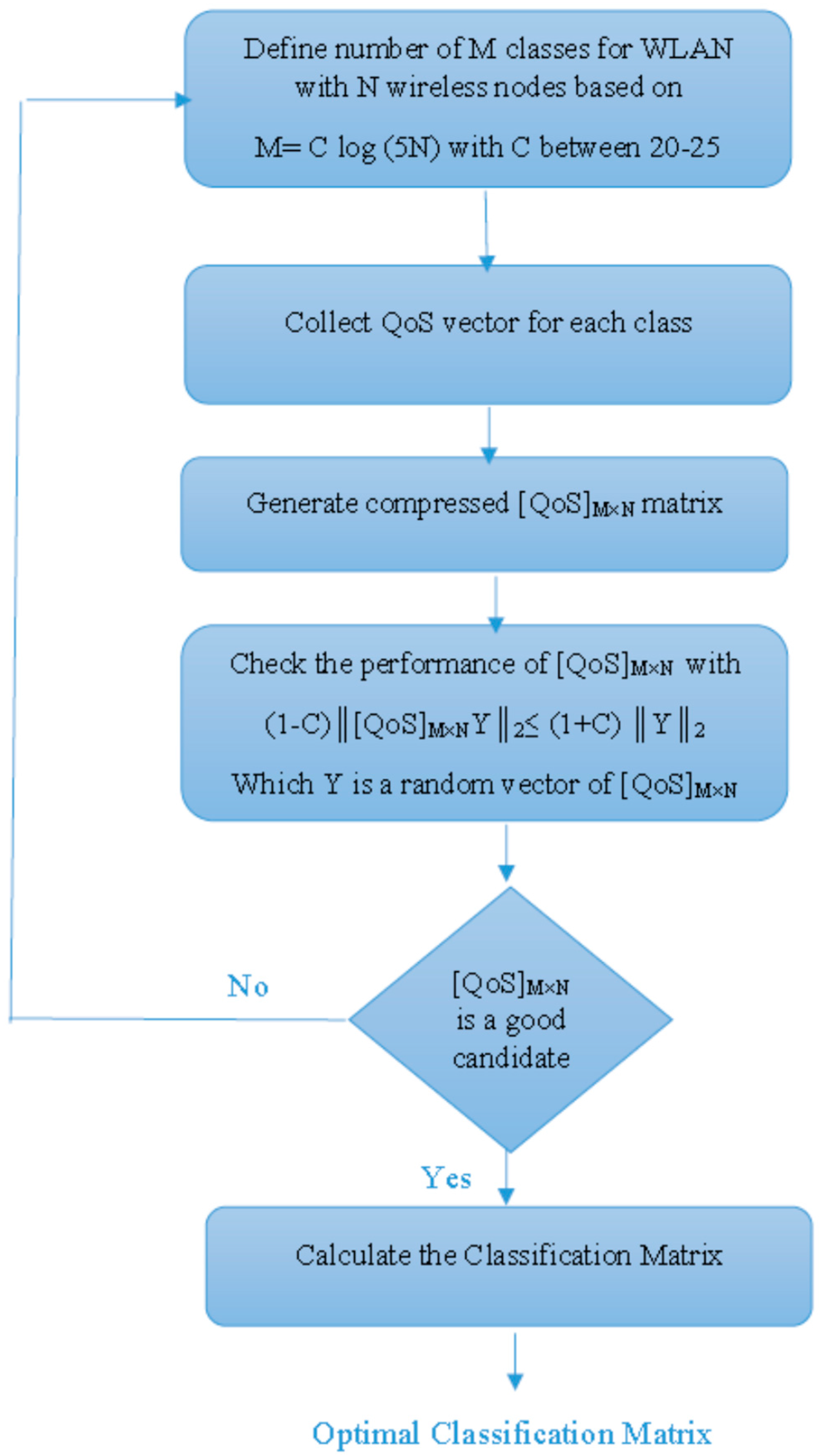
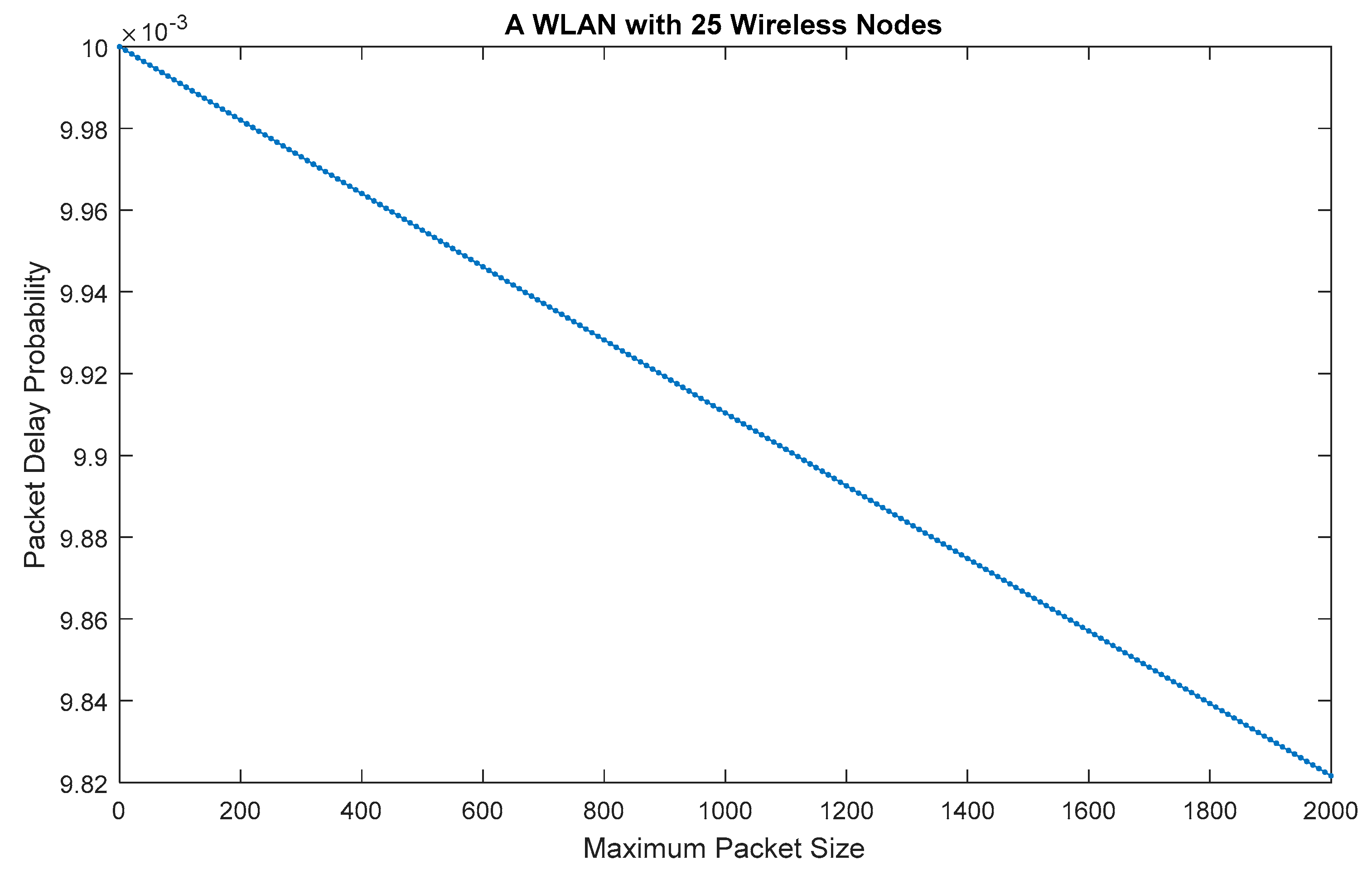
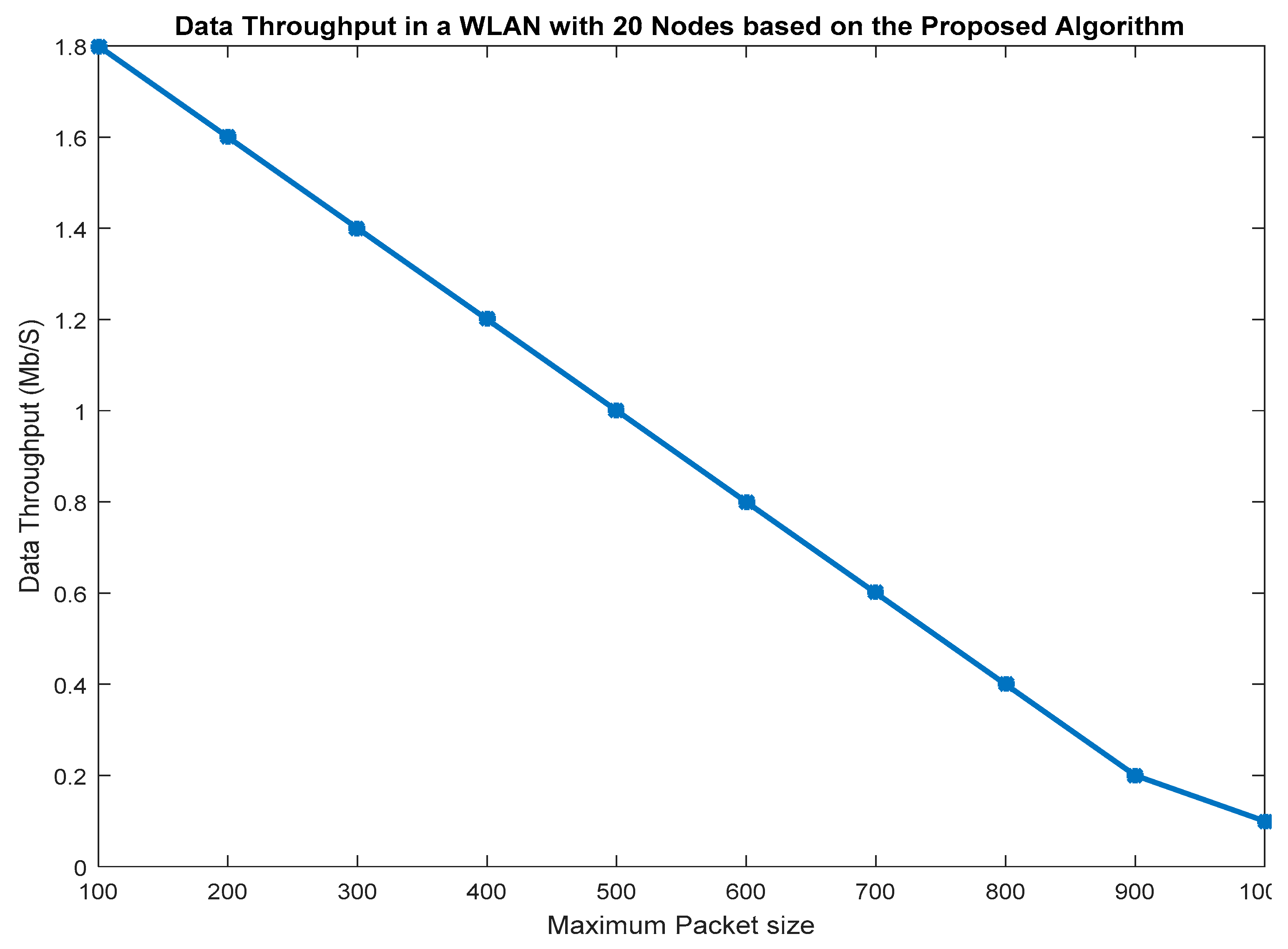
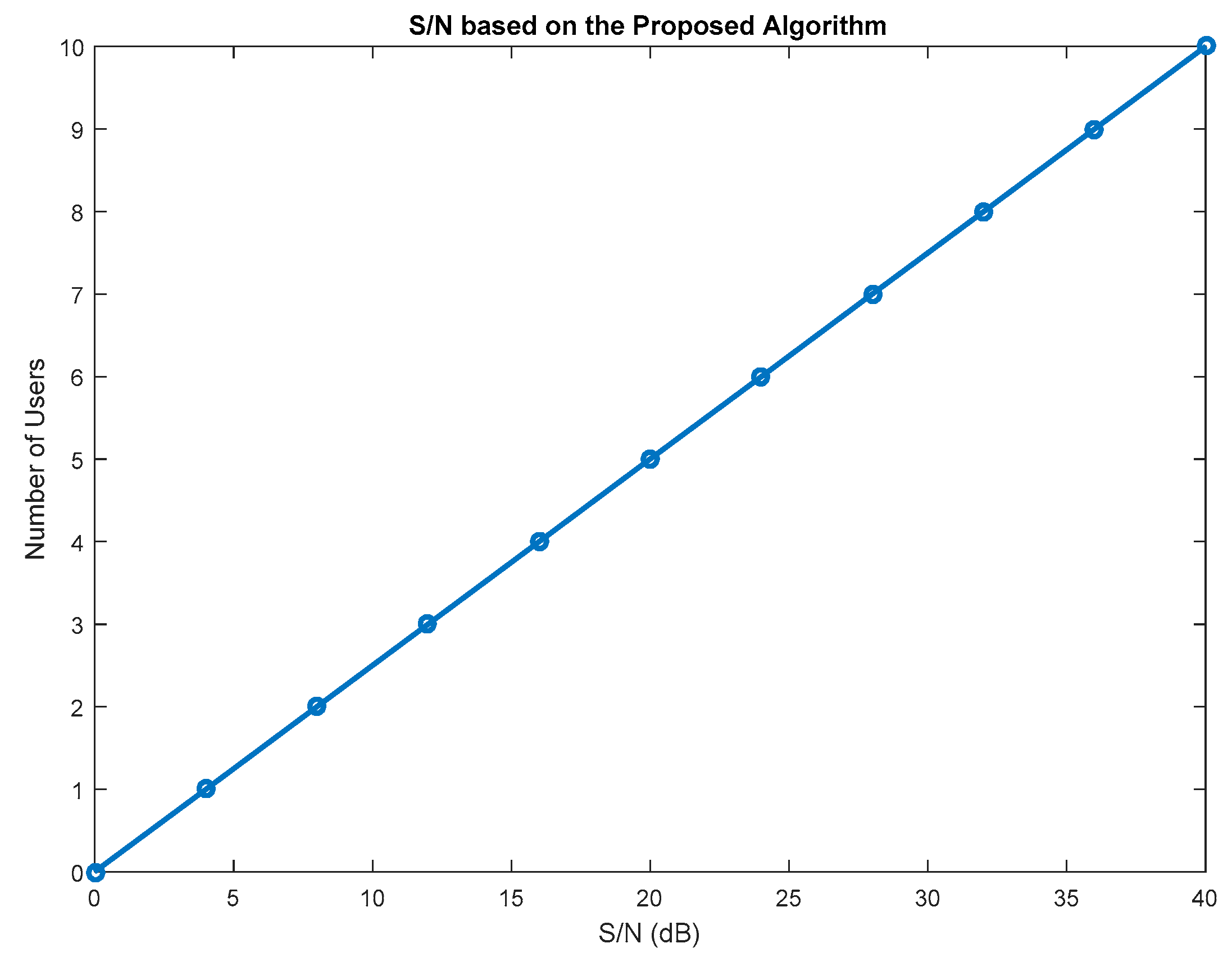
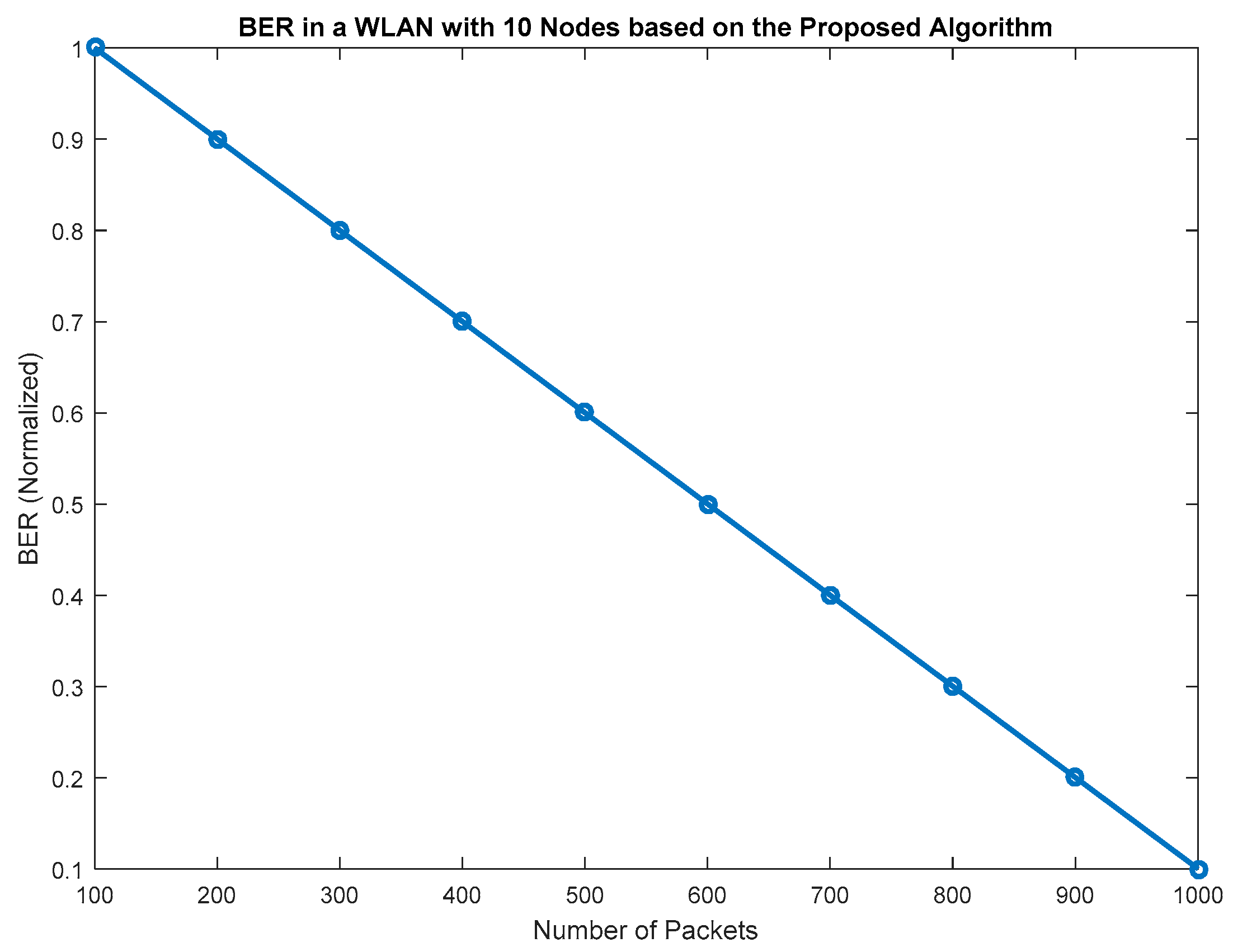
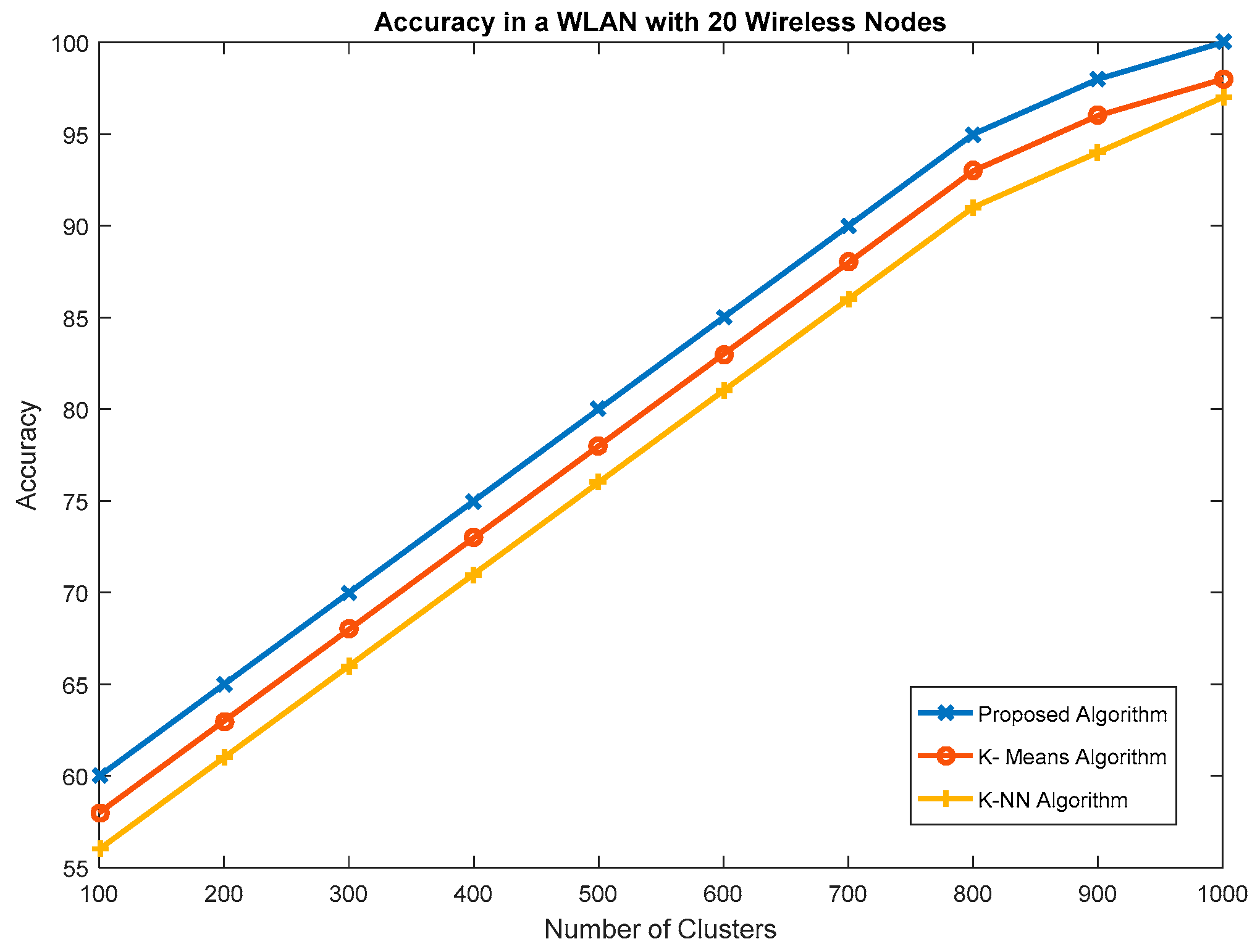
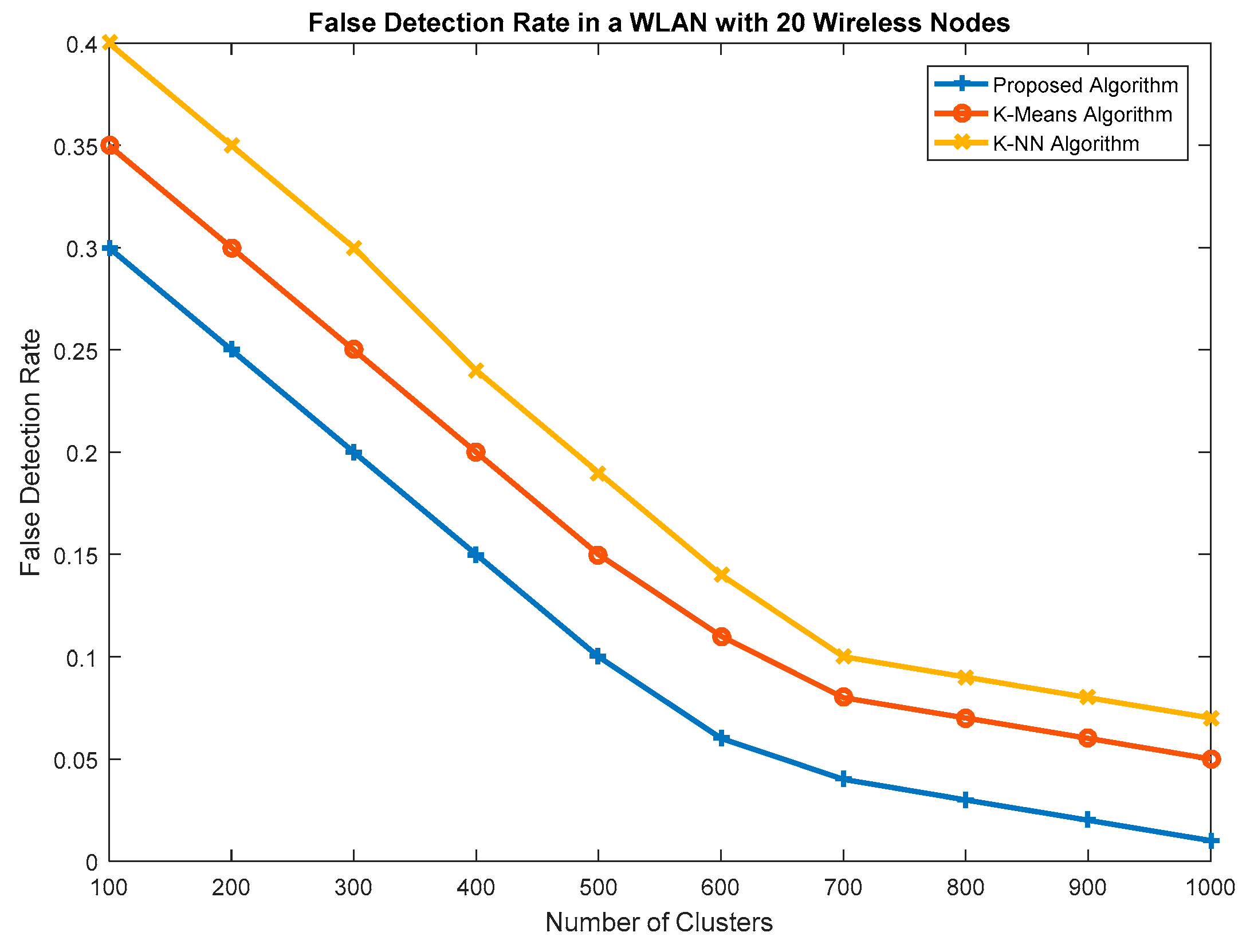

| Qulity of Service (QoS) of a WLAN | Value of MOS |
|---|---|
| Very Satisfied | 3.8–4 |
| Satisfied | 3.5–3.7 |
| Some segments are satisfied | 3.2–3.4 |
| Many segments are dissatisfied | 2.9–3.1 |
| Bad quality | Less than 2.9 |
© 2018 by the author. Licensee MDPI, Basel, Switzerland. This article is an open access article distributed under the terms and conditions of the Creative Commons Attribution (CC BY) license (http://creativecommons.org/licenses/by/4.0/).
Share and Cite
Balouchestani-Asli, M. Robust Wireless Local Area Networks Based on Compressed Sensing. J. Sens. Actuator Netw. 2018, 7, 15. https://doi.org/10.3390/jsan7010015
Balouchestani-Asli M. Robust Wireless Local Area Networks Based on Compressed Sensing. Journal of Sensor and Actuator Networks. 2018; 7(1):15. https://doi.org/10.3390/jsan7010015
Chicago/Turabian StyleBalouchestani-Asli, Mohammadreza. 2018. "Robust Wireless Local Area Networks Based on Compressed Sensing" Journal of Sensor and Actuator Networks 7, no. 1: 15. https://doi.org/10.3390/jsan7010015




